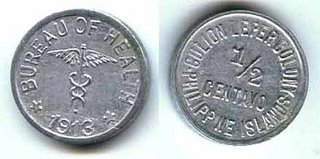 The current day Philippine peso definitely cannot get one a bagful of pan de sal, the islands’ bread staple. Imagine what a half centavo could purchase!
The current day Philippine peso definitely cannot get one a bagful of pan de sal, the islands’ bread staple. Imagine what a half centavo could purchase!Next to nothing. Plus, there is no issue of half centavo on the current set of coins.
However, once upon a time, half centavos were in circulation and did have real purchasing value. During the American occupation of the islands, half centavos were struck for two years – 1903 and 1904. They were quite small in size, especially compared with the rather hefty centavo coins, which as kids we used to call “isa ka daku”, literally meaning, a big one. Of the two years of mint, 1903 is considered easier to find. My tough luck, since my hoard is of the 1903 variety.
Originally colored red or maybe red brown, their small size worked against them. They easily got misplaced. Though struck only for two years, there should be out there tucked snugly in some collectors’ albums or montage, sufficient quantities that could translate to some windfall. The humid tropics are known to be harsh to metals, but basic care to keep them well preserved should not be very difficult.
Based on condition, a half centavo could command as much as US$2,000 – if you can find one. Based on current foreign exchange rates, that would be 100,000 pesos!
Here’s a current offering on EBay.
Maybe it's time again to rummage through Lolo’s or Lola’s old aparador of trinkets and odds-and-ends.
 A little added trivia. In 1913, the local Bureau of Health issued the Culion Leper Colony half centavo. To those unfamiliar, Culion island, part of Palawan, was (is?) a leper colony ran by the bureau, where lepers could be isolated and treated. An uncle doctor was assigned there when I was a kid and thus, I spent part of my youth in the island among the lepers as a chaperone of my grandmother.
A little added trivia. In 1913, the local Bureau of Health issued the Culion Leper Colony half centavo. To those unfamiliar, Culion island, part of Palawan, was (is?) a leper colony ran by the bureau, where lepers could be isolated and treated. An uncle doctor was assigned there when I was a kid and thus, I spent part of my youth in the island among the lepers as a chaperone of my grandmother.
No comments:
Post a Comment